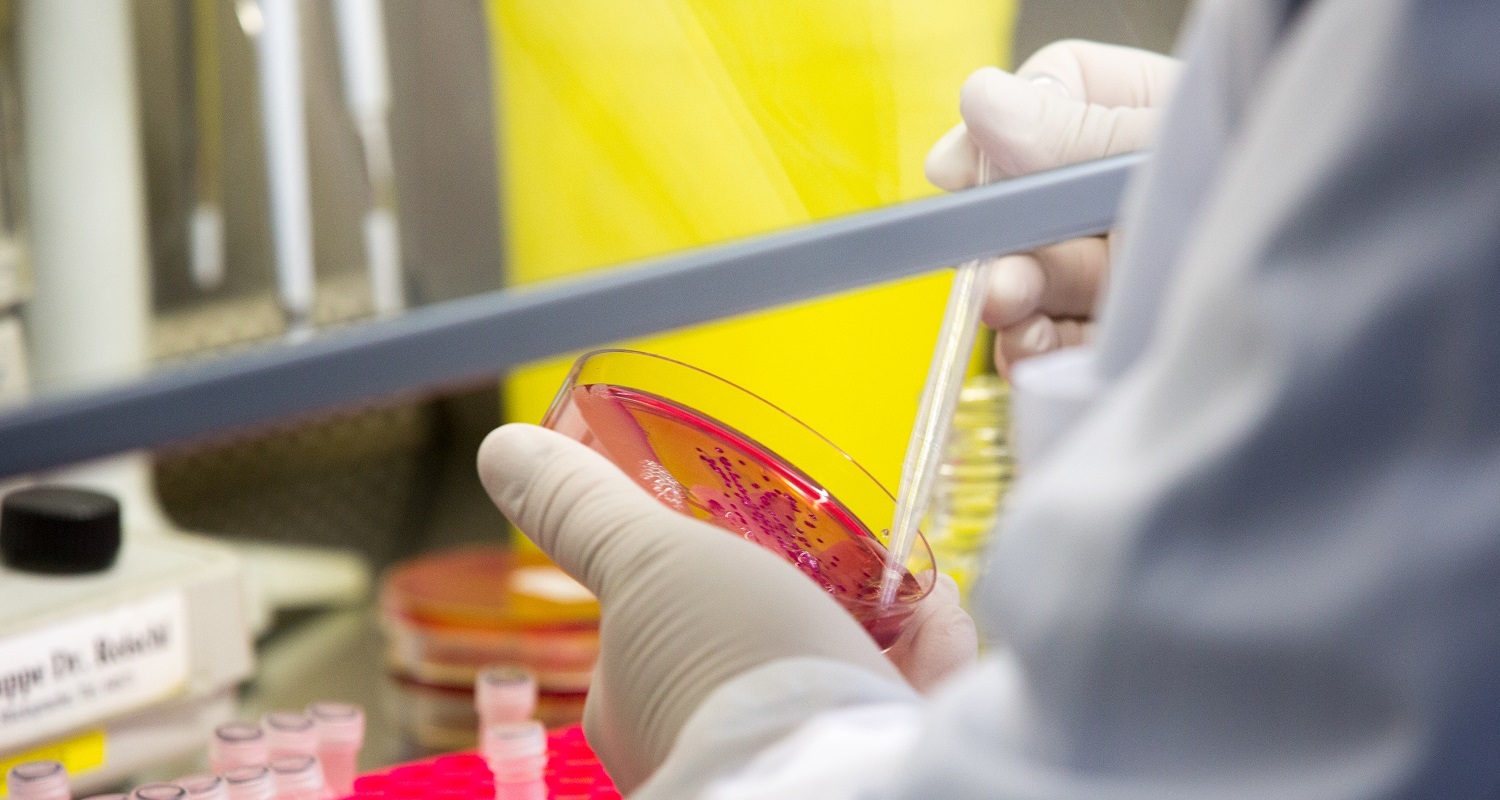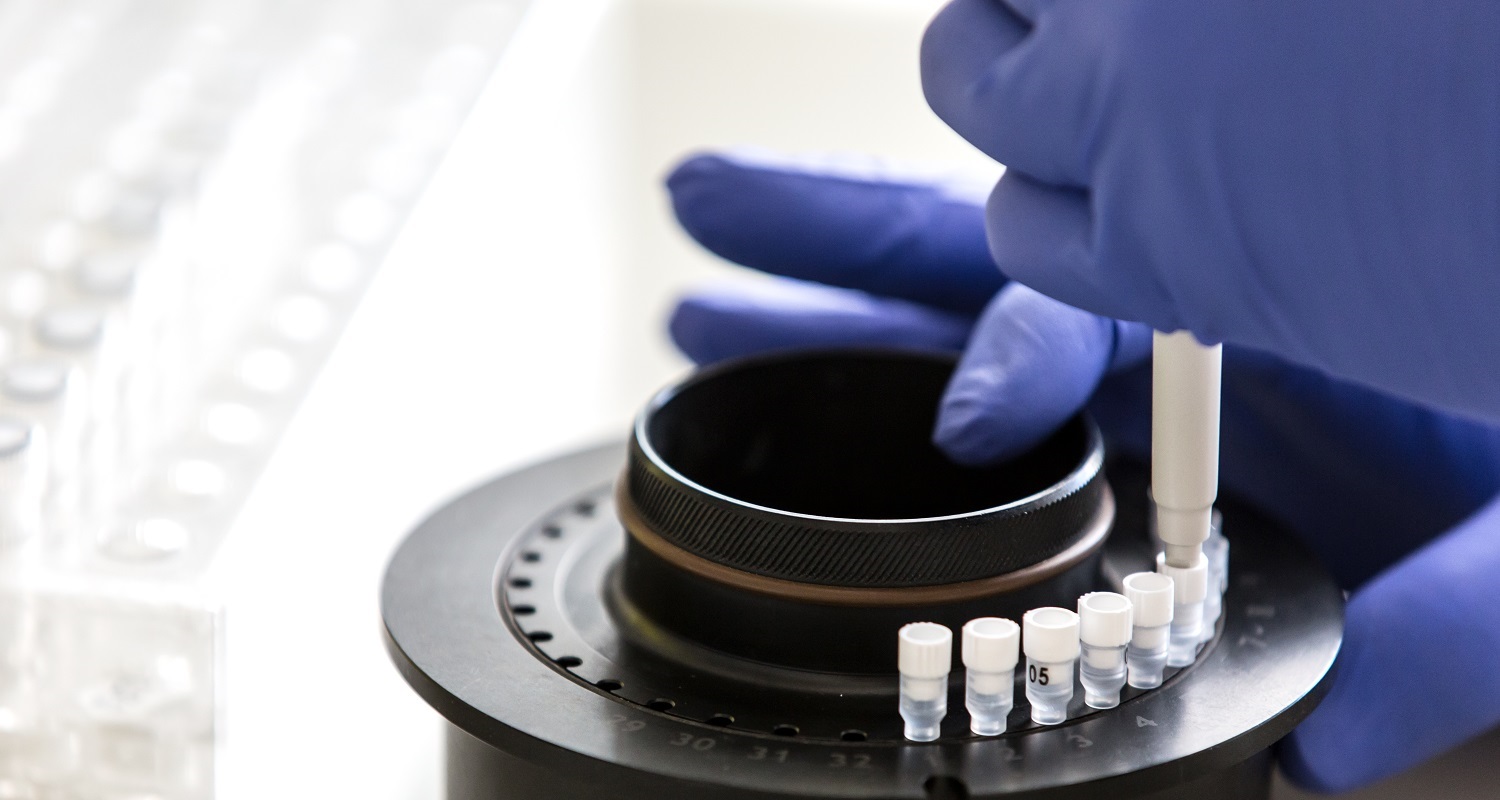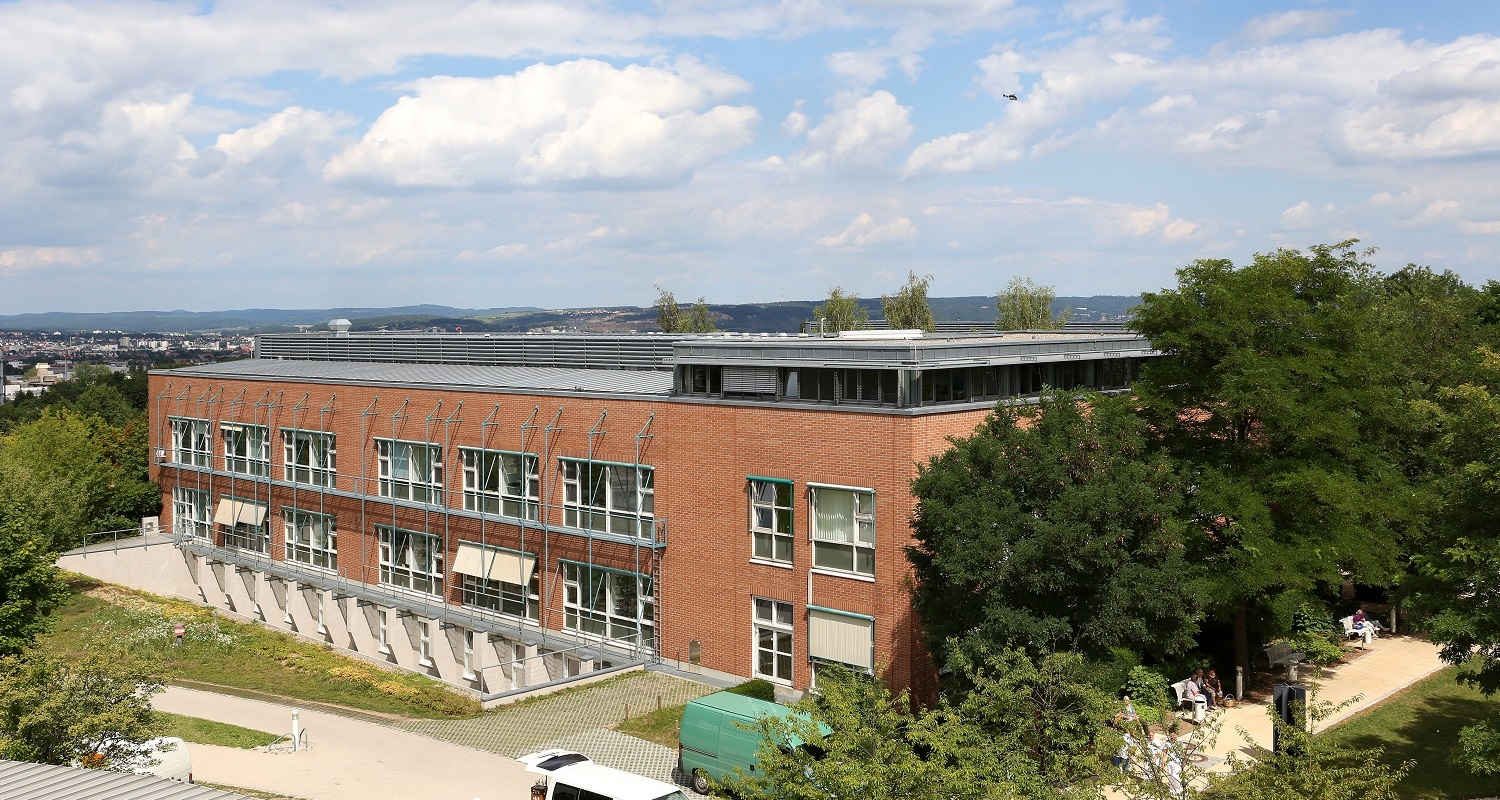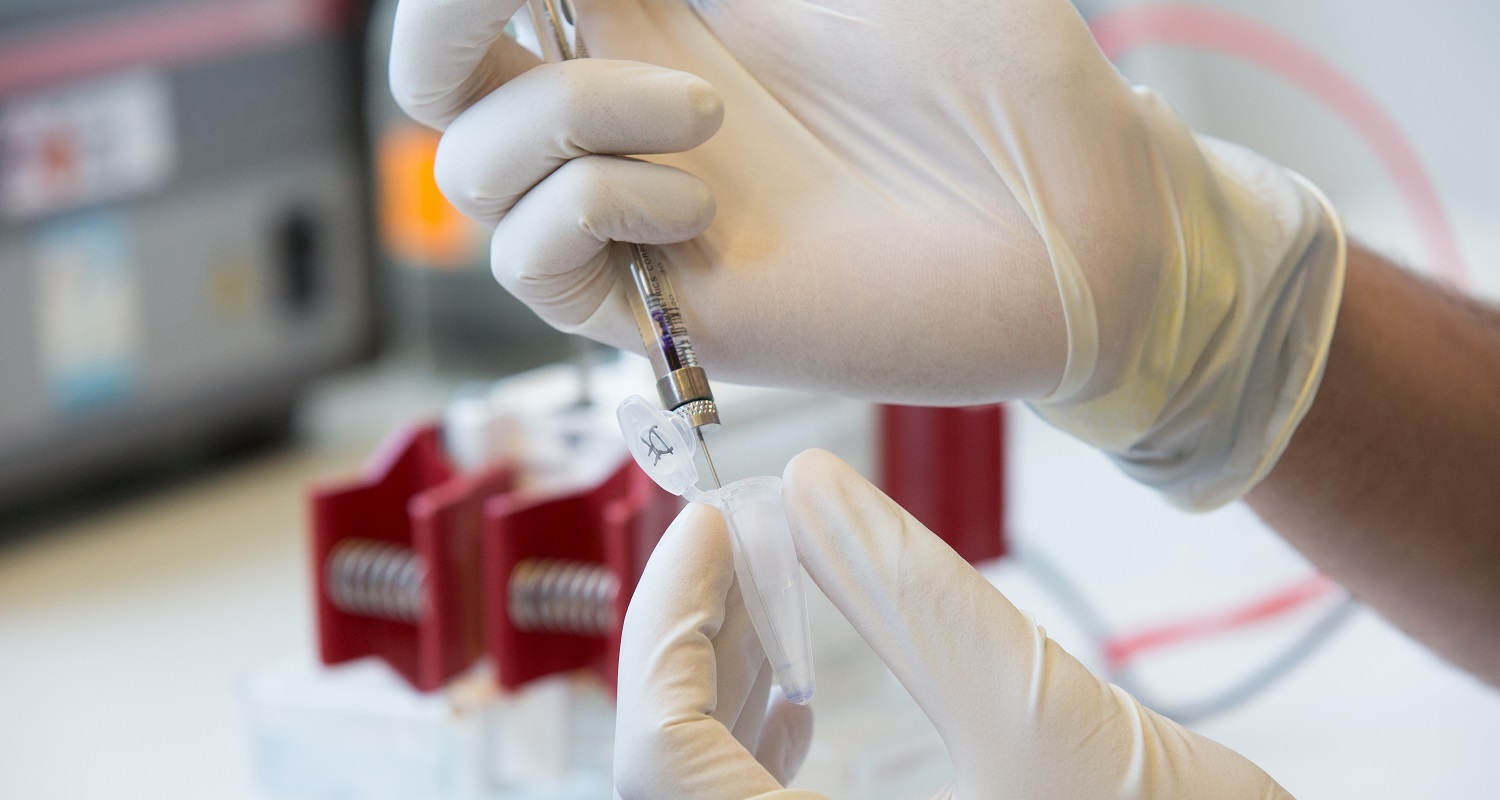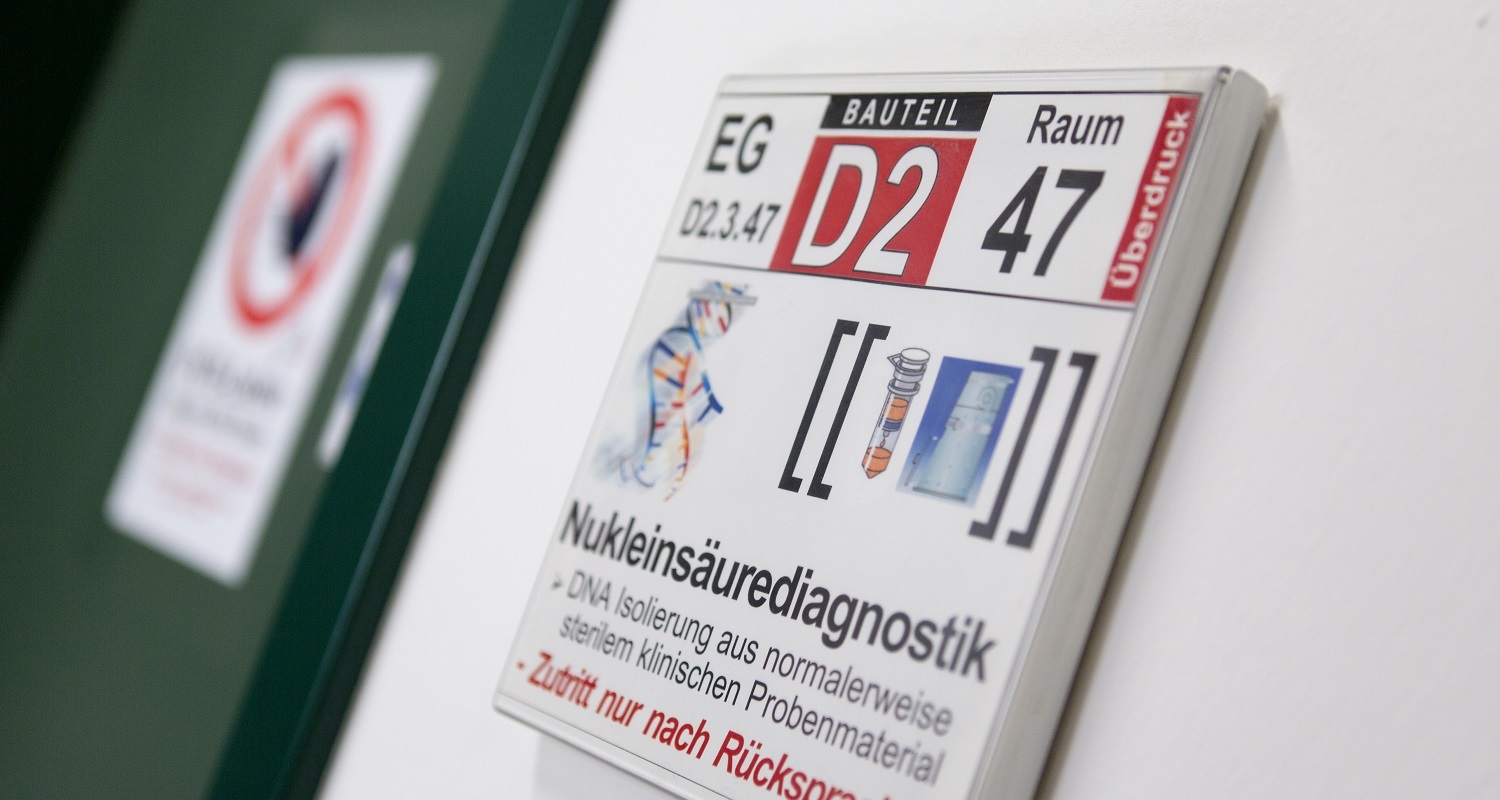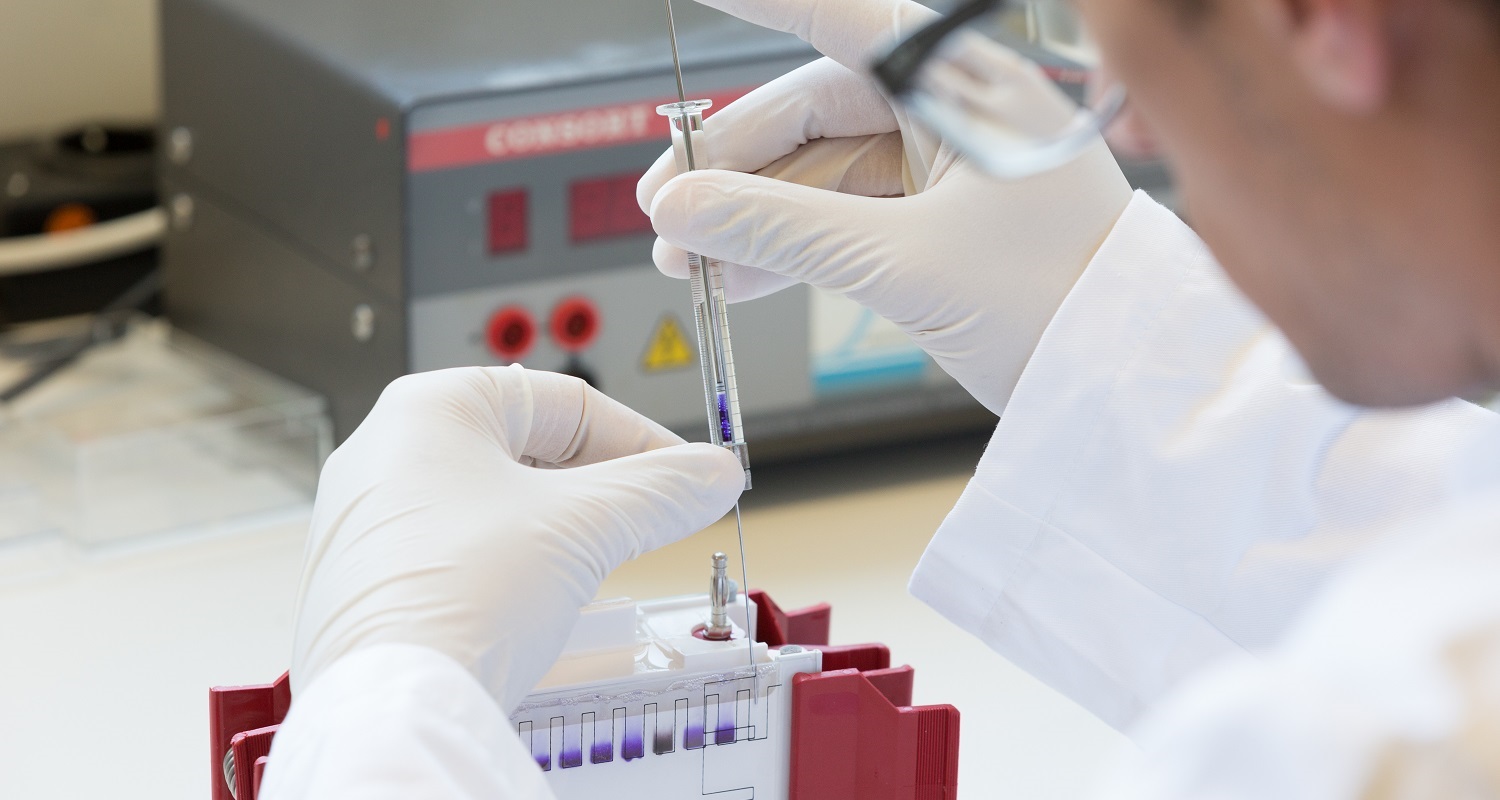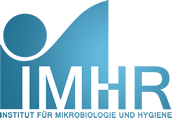Arbeitsgruppe Prof. Hans Helmut Niller

| Telefon | +49 (0) 941 - 944 4633 | ||||
| Telefax | +49 (0) 941 - 944 6402 | ||||
| hans-helmut.niller@ukr.de | |||||
Epstein-Barr-Virus
Viren entwickelten im Laufe der Evolution verschiedene Strategien, um sich in ihrem Wirtsorganismus trotz dessen funktionierendem Immunsystem zu vermehren. Das Epstein-Barr-Virus (EBV) gehört zur Virusfamilie der Herpesviren, die aufgrund einer umfangreichen Ausstattung an Genen in der Lage sind, nach der Erstinfektion lebenslang im menschlichen Körper zu persistieren. Mit einer weltweit hohen Durchseuchungsrate von über 90 % zählt das EBV damit zu den erfolgreichsten Viren.
Die Erstinfektion mit dem EBV erfolgt in der Regel im Kindesalter oder bei jungen Erwachsenen. Der Verlauf der Infektion reicht von einer asymptomatischen nicht klinischen Form bis zu schwerer Infektiöser Mononukleose (Pfeiffersches Drüsenfieber) mit Arbeitsunfähigkeit. In sehr seltenen Fällen geht die Infektiöse Mononukleose in eine chronisch aktive Form und es treten, vor allem in Ostasien, lebensbedrohliche Formen auf.
B-Zellen werden in Zellkultur effizient durch das Virus infiziert und immortalisiert und in ihnen kann das Virus in einer Art Ruheform (Latenz) persistieren. In den Gedächtnis-B-Zellen des Menschen, in bestimmten Klassen von B-Zelltumoren (endemisches Burkitt Lymphom, Hodgkin Lymphom) und auch in Nasopharyngealen Karzinomen kann das Virus ebenfalls latent persistieren. Die Gedächtniszellen bilden das lebenslange Reservoir des Virus. Die Latenzformen des EBV in Zellkultur, in Gedächtniszellen und in Tumorzellen unterscheiden sich durch das Expressionsprogramm zellulärer und viraler Gene. In der Arbeitsgruppe von Dr. Hans Helmut Niller beschäftigt man sich im Detail mit der Replikation und der Chromatinstruktur der latenten EBV-Genome in den veschiedenen Latenzformen.
Obwohl in den meisten infizierten B-Zellen das EBV latent überdauert, geht das Virus in einem Teil dieser Zellen in die lytische Vermehrung über. Eine strikte Kontrolle dieser Vermehrung verhindert eine Zerstörung der B-Zellen und sichert damit das Überleben des Virus und des Wirtes. Dies geschieht auf der Ebene der viralen Genregulation und auf der Ebene der Überwachung durch das menschliche Immunsystem. Die viralen Faktoren, die zur Entstehung von EBV-assoziierten Tumoren führen, sind nur zum Teil bekannt. Eine sehr frühe Infektion mit EBV, genetische Prädisposition und lokale Ernährungsgewohnheiten werden mit der Entstehung solcher Tumoren assoziiert. Auch eine unzureichende Immunerkennung EBV-infizierter Zellen, beispielsweise in Fällen von angeborener oder erworbener Immunschwäche wie Immunsuppression nach Organtransplantationen oder nach einer Infektion mit dem HI-Virus (AIDS), ist daran beteiligt.
Eine effiziente Erkennung und Zerstörung latent oder lytisch infizierter Zellen durch das Immunsystem stellt das letzte Glied in der Kontrolle der EBV-Infektion im Wirt dar. Zytotoxische T-Zellen (CTL) erkennen die Produkte der Schaltgene der lytischen Vermehrung des Virus und können produktiv infizierte Zellen zerstören. Lange nach der Erstinfektion bleiben Gedächtnis-T-Zellen nachweisbar und sind an der Kontrolle der Virusvermehrung beteiligt. Derzeit gibt es keine spezifische Therapie für klinisch auffällige, chronisch aktive EBV-Infektionen, die häufig zu malignen EBV-assoziierten Lymphomen führen.
UNSERE PROJEKTE
Alle aktuellen Projekte unserer Arbeitsgruppe auf einen Blick:
MITARBEITER
Hier finden Sie den richtigen Ansprechpartner:
UNSERE NEWS
Alle aktuellen News unserer Arbeitsgruppe auf einen Blick:
Liste aller Publikationen:
First description of herpesviral Thymidylate Synthase:
Honess, R. W., W. Bodemer, K. R. Cameron, H. H. Niller, B. Fleckenstein, and R. E. Randall. 1986. The A+T-rich genome of herpesvirus saimiri contains a highly conserved gene for thymidylate synthase. Proceedings of the National Academy of Sciences of the USA 83:3604-3608.
Bodemer, W., H. H. Niller, N. Nitsche, B. Scholz, and B. Fleckenstein. 1986. Organization of the thymidylate synthase gene of herpesvirus saimiri. Journal of Virology 60:114-123.
Niller, H. H., N. Nitsche, R. Rüger, I. Puchtler, W. Bodemer, and B. Fleckenstein. 1987. The thymidylate synthase gene of herpesvirus saimiri. In Viruses and Human Cancer, 443-450. eds. R. C. Gallo, W. Haseltine, G. Klein, and H. zur Hausen. Alan R. Liss, Inc.
Niller, H. H., and L. Hennighausen. 1990. Phytohemagglutinin-induced activity of cyclic AMP (cAMP) response elements from cytomegalovirus is reduced by cyclosporine and synergistically enhanced by cAMP. Journal of Virology 64:2388- 2391.
Niller, H. H., and L. Hennighausen. 1991. Formation of several specific nucleoprotein complexes on the human cytomegalovirus immediate early enhancer. Nucleic Acids Research 19:3715- 3721.
Ikuyama, S., H. H. Niller, H. Shimura, T. Akamizu, and L. D. Kohn. 1992. Characterization of the 5´-flanking region of the rat thyrotropin receptor gene. Molecular Endocrinology 6:793-804.
Niller, H. H., G. Glaser, R. Knüchel, and H. Wolf. 1995. Nucleoprotein complexes and DNA 5´-ends at oriP of Epstein-Barr virus. Journal of Biological Chemistry 270:12864-12868.
Kochanowski, B., H. H. Niller, W. Jilg und H. Wolf. 1996. Epstein-Barr-Virus. In Diagnostische Bibliothek, Band 1, Virusdiagnostik, 235-257. Hrsg. Tomas Porstmann. Blackwell Wissenschafts-Verlag
Vogel, M., K. Wittmann, E. Endl, G. Glaser, R. Knüchel, H. Wolf, and H. H. Niller. 1998. Plasmid maintenance assay based on green fluorescent protein and FACS of mammalian cells. Bio-Techniques 24:540-544.
Glaser, G., M. Vogel, H. Wolf, and H. H. Niller. 1998. Regulation of the Epstein-Barr viral immediate early BRLF1 promoter through a distal NF1 site. Archives of Virology 143:1967-1983.
Salamon, D., M. Takacs, D. Ujvari, J. Uhlig, H. Wolf, J. Minarovits, and H. H. Niller. 2001. Protein-DNA-binding and CpG-methylation at nucleotide resolution of latency associated promoters Qp, Cp, and LMP1p of Epstein-Barr virus. Journal of Virology 75:2584-2596.
Takacs, M., D. Salamon, S. Myöhänen, H. Li, J. Segesdi, D. Ujvari, J. Uhlig, H. H. Niller, H. Wolf, G. Berencsi, and J. Minarovits. 2001. Epigenetics of latent Epstein-Barr virus genomes: high resolution methylation analysis of the bidirectional promoter region of latent membrane protein 1 and 2B genes. Biological Chemistry 382:699-705.
Linde, H.-J., M. Schmidt, E. Fuchs, U. Reischl, H. H. Niller, and N. Lehn. 2001. In vitro activities of six quinolones and mechanisms of resistance in Staphylococcus aureus and coagulase-negative staphylococci. Antimicrobial Agents and Chemotherapy 45:1553-1557.
Hoves, S., H. H. Niller, S. W. Krause, R. Straub, T. Glück, J. D. Mountz, J. Schölmerich, and M. Fleck. 2001. Decreased T cell stimulatory capacity of monocyte-derived human macrophages following herpes simplex virus type 1 infection. Scandinavian Journal of Immunology 54:93-99.
Niller, H, H., D. Salamon, M. Takacs, J. Uhlig, H. Wolf, and J. Minarovits. 2001. Protein-DNA binding and CpG methylation at rep*/vIL-10p of latent Epstein-Barr virus genomes in lymphoid cell lines. Biological Chemistry 382:1411-1419.
Dobner, T., D. Büchner, T. Zeller, H. Wolf, and H. H. Niller. 2001. Specific nucleoprotein complexes within adenovirus capsids. Biological Chemistry 382:1373-1377.
Notka, F., H.-J. Linde, A. Dankesreiter, H. H. Niller, and N. Lehn. 2002. A C-terminal 18 amino acid deletion in MarR in a clinical isolate of Escherichia coli reduces MarR binding properties and increases the MIC of ciprofloxacin. Journal of Antimicrobial Chemotherapy 49:41-47.
Raab, U., K. Beckenlehner, T. Lowin, H. H. Niller, S. Doyle, and S. Modrow. 2002. NS1 protein of parvovirus B19 interacts directly with DNA sequences of the p6 promoter and with the cellular transcription factors Sp1/Sp3. Virology 293:86-93.
Niller, H. H., D. Salamon, J. Uhlig, S. Ranf, M. Granz, F. Schwarzmann, H. Wolf, and J. Minarovits. 2002. Nucleoprotein structure of immediate early promoters Zp and Rp, and of oriLyt of latent Epstein-Barr virus genomes. Journal of Virology 76:4113-4118.
Linde, H. J., F. Notka, C. Irtenkauf, J. Decker, J. Wild, H. H. Niller, P. Heisig, and N. Lehn. 2002. Increase in MICs of ciprofloxacin in vivo in two closely related clinical isolates of Enterobacter cloacae. Journal of Antimicrobial Chemotherapy 49:625-630.
Niller, H. H., D. Salamon, K. Ilg, A. Koroknai, F. Banati, G. Bäuml, O. L. Rücker, F. Schwarzmann, H. Wolf, and J. Minarovits. 2003. The in vivo binding site for oncoprotein c-Myc in the promoter for Epstein-Barr virus (EBV) encoded RNA (EBER) 1 suggests a specific role for EBV in lymphomagenesis. Medical Science Monitor 9:HY1-9.
de Jesus, O., P. R. Smith, L. Spender, C. Elgueta Karstegl, H. H. Niller, D. P. Huang, and P. J. Farrell. 2003. Updated Epstein-Barr virus (EBV) DNA sequence and analysis of a promoter for the BART (CST, BARF0) RNAs of EBV. Journal of General Virology 84:1443-1450.
Salamon, D., M. Takacs, F. Schwarzmann, H. Wolf, J. Minarovits, and H. H. Niller. 2003. High-resolution methylation analysis and in vivo protein-DNA binding at the promoter of the viral oncogene LMP2A in B cell lines carrying latent Epstein-Barr virus genomes. Virus Genes 27:57-66.
Rehli, M., H. H. Niller, C. Ammon, S. Langmann, L. Schwarzfischer, R. Andreesen, and S. W. Krause. 2003. Transcriptional regulation of CHI3L1, a marker gene for late stages of macrophage differentiation. Journal of Biological Chemistry 278:44058-44067.
Speer, G., M. Toth, H. H. Niller, D. Salamon, I. Takacs, P. Miheller, A. Patocs, Z. Nagy, E. Bajnok, P. Nyiri, and P. Lakatos. 2003. Calcium metabolism and endocrine functions in a family with familial hypocalciuric hypercalcemia. Experimental and Clinical Endocrinology and Diabetes 111:486-490.
Niller, H. H., D. Salamon, K. Ilg, A. Koroknai, F. Banati, F. Schwarzmann, H. Wolf, and J. Minarovits. 2004. EBV-associated neoplasms: alternative pathogenetic pathways. Medical Hypotheses 62:387-391.
Niller, H. H., D. Salamon, K. Ilg, A. Koroknai, F. Banati, F. Schwarzmann, H. Wolf, and J. Minarovits. 2004. The LCR of EBV makes Burkitt´s lymphoma endemic. Trends in Microbiology 12:495-499.
Niller, H. H., D. Salamon, S. Rahmann, K. Ilg, A. Koroknai, F. Banati, F. Schwarzmann, H. Wolf, and J. Minarovits. 2004. A 30 kb region of the Epstein-Barr virus genome is colinear with the rearranged human immunoglobulin gene loci: implications for a "Ping-Pong evolution" model for persisting viruses and their hosts. Acta Microbiologica et Immunologica Hungarica 51:469-484.
Niller, H. H, H. Wolf, and J. Minarovits. 2007. Epstein Barr virus. In Latency Strategies of Herpesviruses. J. Minarovits, E. Gonczol and T. Valyi-Nagy eds., 154-191. Springer.
Bakos, A., F. Banati, A. Koroknai, M. Takacs, D. Salamon, S. Minarovits-Kormuta, F. Schwarzmann, H. Wolf, H. H. Niller, and J. Minarovits. 2007. High-resolution analysis of CpG methylation and in vivo protein-DNA interactions at the alternative Epstein-Barr virus latency promoters Qp and Cp in the nasopharyngeal carcinoma cell line C666-1. Virus Genes 35:195-202.
Gerle, B., A. Koroknai, G. Fejer, A. Bakos, F. Banati, K. Szenthe, H. Wolf, H. H. Niller, J. Minarovits, and D. Salamon. 2007. Acetylated histone H3 and H4 mark the upregulated LMP2A promoter of Epstein-Barr Virus in lymphoid cells. Journal of Virology 81:13242–13247.
Banati, F., A. Koroknai, D. Salamon, M. Takacs, S. Minarovits-Kormuta, H. Wolf, H. H. Niller, and J. Minarovits. 2008. CpG-methylation silences the activity of the RNA polymerase III transcribed EBER-1 promoter of Epstein-Barr virus. FEBS Letters 582:705-709.
Niller, H. H., H. Wolf, and J. Minarovits. 2008. Regulation and dysregulation of Epstein-Barr virus latency: implications for the development of autoimmune diseases. Autoimmunity 41:298-328.
Fejer, G., A. Koroknai, F. Banati, I. Gyory, D. Salamon, H. Wolf, H. H. Niller, and J. Minarovits. 2008. Latency type-specific distribution of epigenetic marks at the alternative promoters Cp and Qp of EpsteinBarr virus. Journal of General Virology 89:1364-1370.
Takacs, M., J. Segesdi, F. Banati, A. Koroknai, H. Wolf, H. H. Niller, J. Minarovits. 2009. The importance of epigenetic alterations in the development of Epstein-Barr virus-related lymphomas. Mediterranean Journal of Hematology and Infectious Diseases 1(2):e2009012.
Salamon, D., F. Banati, A. Koroknai, M. Ravasz, K. Szenthe, Z. Bathori, A. Bakos, H. H. Niller, H. Wolf, and J. Minarovits. 2009. Binding of CCCTC-binding factor in vivo to the region located between Rep* and the C promoter of Epstein-Barr virus is unaffected by CpG methylation and does not correlate with Cp activity. Journal of General Virology 90:1183-1189.
First Diagnosis of Pandemic Swine Flu H1N1/09 in Germany:
Melzl, H, J. J. Wenzel, B. Kochanowski, K. Feierabend, B. Kreuzpaintner, E. Kreuzpaintner, A. Rohrhofer, S. Schreder-Meindl, H. Wollner, B. Salzberger, U. Reischl, W. Jilg, H. Wolf, and H. H. Niller. 2009. First sequence-confirmed case of infection with the new influenza A(H1N1) strain in Germany. Euro Surveillance 14:pii=19203.
Avialable online: http://www.eurosurveillance.org/ViewArticle.aspx?ArticleId=19203.
Niller, H. H., H. Wolf, and J. Minarovits. 2009. Epigenetic dysregulation of the host cell genome in Epstein-Barr virus-associated neoplasia. Seminars in Cancer Biology 19:158-164.
Kern, M., S. Böhm, L. Deml, H. Wolf, U. Reischl, and H. H. Niller. 2009. Inhibition of Legionella pneumophila PCR in respiratory samples: A quantitative approach. Journal of Microbiological Methods 79:189-193
Panning, M., M. Eickmann, O. Landt, M. Monazahian, S. Olschläger, S. Baumgarte, U. Reischl, J. J. Wenzel, H. H. Niller, S. Günther, B. Hollmann, D. Huzly, J. F. Drexler, A. Helmer, S. Becker, B. Matz, A. Eis-Hübinger, and C. Drosten. 2009. Detection of influenza A(H1N1)v virus by real-time RT-PCR. Euro Surveillance 14:pii=19329.
Available online: http://www.eurosurveillance.org/ViewArticle.aspx?ArticleId=19329
Wenzel, J. J., H. Walch, M. Bollwein, H. H. Niller, W. Ankenbauer, R. Mauritz, H. J. Höltke, H. M. Zepeda, H. Wolf, W. Jilg, and U. Reischl. 2009. Library of Prefabricated Locked Nucleic Acid Hydrolysis Probes Facilitates Rapid Development of Reverse-Transcription Quantitative Real-Time PCR Assays for Detection of Novel Influenza A/H1N1/09 Virus. Clinical Chemistry 55:2218-2222.
Takacs, M., F. Banati, A. Koroknai, J. Segesdi, D. Salamon, H. Wolf, H. H. Niller, J. Minarovits. 2010. Epigenetic regulation of latent Epstein–Barr virus promoters. Biochimica et Biophysica Acta 1799:228–235.
Niller, H. H., H. Wolf, E. Ay, and J. Minarovits. 2010. Epigenetic dysregulation of Epstein-Barr virus latency and development of autoimmune disease. In Epigenetic contributions in autoimmune disease, 82-102. E. Ballestar ed., Landes Bioscience. Also published in: Advances in Experimental Medicine and Biology 2011 711:82-102.
Minarovits, J., F. Banati, and H. H. Niller. 2011. Viral hit-and-run tumorigenesis. Future Virology 6:13-15.
Niller, H. H., H. Wolf, and J. Minarovits. 2011. Viral hit and run-oncogenesis: Genetic and epigenetic scenarios. Cancer Letters 305:210-217.
Niller, H. H. 2010. Myelodysplastic syndrome (MDS) as a late stage of subclinical hemophagocytic lymphohistiocytosis (HLH): a putative role for Leptospira infection. A hypothesis. Acta Microbiologica et Immunologica Hungarica 57:181-189.
Kittan, N. A., F. Beier, K. Kurz, H. H. Niller, L. Egger, W. Jilg, R. Andreesen, E. Holler, and G. C. Hildebrandt. 2011. Isolated cerebral manifestation of Epstein-Barr virus-associated post-transplant lymphoproliferative disorder after allogeneic hematopoietic stem cell transplantation: a case of clinical and diagnostic challenges. Transplant Infectious Disease doi: 10.1111/j.1399-3062.2011.00621.x.
Niller, H. H. and J. Minarovits. 2012. EBV, autoimmunity and dual T-cell receptors. Future Virology 7:217-220.
Niller, H. H., and J. Minarovits. 2012. Epigenetics and human infectious diseases. In Epigenetics in Human Disease., T. Tollefsbol ed., 415-442, Elsevier.
Niller, H. H., F. Banati, E. Ay, and J. Minarovits. 2012. Epigenetic changes in virus-associated neoplasms. In Patho-Epigenetics of Human Disease, Chapter 8. J. Minarovits and H. H. Niller eds., 179-225, Springer.
Niller, H. H., F. Banati, E. Ay, and J. Minarovits. 2012. Microbe-induced epigenetic alterations. In Patho-Epigenetics of Human Disease, Chapter 14. J. Minarovits and H. H. Niller eds., 419-455, Springer.
Niller, H. H., and J. Minarovits. 2012. Similarities between the Epstein-Barr virus (EBV) nuclear protein EBNA1 and the pioneer transcription factor FoxA: Is EBNA1 a “bookmarking” oncoprotein that alters the host cell epigenotype? Pathogens 1:37-51.
Szenthe, K., K. Nagy, K. Buzas, H. H. Niller, and J. Minarovits. 2013. MicroRNAs as targets and tools in B-cell lymphoma therapy. Journal of Cancer Therapy 4:466-474.
Szenthe, K., A. Koroknai, F. Banati, Z. Bathori, R. Lozsa, J. Burgyan, H. Wolf, D. Salamon, K. Nagy, H. H. Niller, and J. Minarovits. 2013. The 5' regulatory sequences of active miR-146a promoters are hypomethylated and associated with euchromatic histone modification marks in B lymphoid cells. Biochemical and Biophysical Research Communications 433:489-495
Szenthe K, A. Koroknai, F. Banati, Z. Bathori, H. H. Niller, H. Wolf, N. Nagy, E. Klein, J. Minarovits, and D. Salamon. 2013. The role of DNA hypomethylation, histone acetylation and in vivo protein-DNA binding in Epstein-Barr virus-induced CD23 upregulation. Biochemical and Biophysical Research Communications 435:8-15.
Ruzek, D., G. Dobler, and H. H. Niller. 2013. May early intervention with high dose intravenous immunoglobulin pose a potentially successful treatment for severe cases of tick-borne encephalitis? BMC Infectious Diseases 13:306.
Ay, E., F. Banati, M. Mezei, A. Bakos, H. H. Niller, K. Buzás, and J. Minarovits. 2013. Epigenetics of HIV Infection: Promising Research Areas and Implications for Therapy. AIDS Reviews 15:181-188.
Niller, H. H., and J. Minarovits. 2013. Patho-Epigenetics. Medical Epigenetics 1:37-45.
Niller, H. H., F. Banati, K. Nagy, K. Buzas, and J. Minarovits. 2013. Update on microbe-induced epigenetic changes: bacterial effectors and viral oncoproteins as epigenetic dysregulators. Future Virology 8:1111-1126.
Niller, H. H., F. Banati, and J. Minarovits. 2014. Epigenetic alterations in nasopharyngeal carcinoma and Epstein-Barr virus (EBV) associated gastric carcinoma: a lesson in contrasts. Journal of Nasopharyngeal Carcinoma 1:e9.
Niller, H. H., Z. Tarnai, G. Decsi, A. Zsedenyi, F. Banati, and J. Minarovits. 2014. The role of epigenetics in Epstein-Barr virus regulation and pathogenesis. Future Microbiology 9:747-756.
Niller, H. H., K. Szenthe, and J. Minarovits. 2014. Epstein-Barr virus (EBV)-host cell interactions: an epigenetic dialogue? Frontiers in Genetics 5:367.
von Stülpnagel C., P. Winkler, J. Koch J, C. Zeches-Kansy, A. Schöttler-Glas, G. Wolf, H. H. Niller, M. Staudt, G. Kluger, and K. Rostasy. 2016. MRI-imaging and clinical findings of eleven children with tick-borne encephalitis and review of the literature. European Journal of Paediatric Neurology 20:45-52.
Niller, H. H., E. Ay, F. Banati, A. Demcsák, M. Takacs, and J. Minarovits. 2016. Wild type HBx and truncated HBx: Pleiotropic regulators driving sequential genetic and epigenetic steps of hepatocarcinogenesis and progression of HBV-associated neoplasms. Reviews in Medical Virology 26:57-73.
Minarovits, J., F. Banati, K. Szenthe, and H. H. Niller. 2016 Epigenetic regulation. Advances in Experimental Medicine and Biology 879:1-25.
Niller, H. H., F. Banati, D. Salamon, and J. Minarovits. 2016. Epigenetic Alterations in Epstein-Barr Virus-Associated Diseases. Advances in Experimental Medicine and Biology. 879:39-69.
Minarovits, J., A. Demcsák, F. Banati, and H. H. Niller. 2016. Epigenetic Dysregulation in Virus-Associated Neoplasms. Advances in Experimental Medicine and Biology. 879:71-90.
Niller, H. H., and J. Minarovits. 2016. Patho-epigenetics of Infectious Diseases Caused by Intracellular Bacteria. Advances in Experimental Medicine and Biology. 879:107-130.
Ernberg, I., H. H. Niller, and J. Minarovits. 2016. Epigenetic Alterations of Viral and Cellular Genomes in EBV-Infected Cells. In Epigenetics - A Different Way of Looking at Genetics, Chapter 6, W. Doerfler and P. Böhm eds., 91-122, Springer.
Minarovits, J., and H. H. Niller. 2017. Current Trends and Alternative Scenarios in EBV Research. Methods in Molecular Biology. 1532:1-32.
Niller, H. H., and G. Bauer. 2017. Epstein-Barr virus: Clinical Diagnostics. Methods in Molecular Biology. 1532:33-55.
Elsterova, J., M. Palus, J. Sirmarova, J. Kopecky, H. H. Niller, and D. Ruzek. 2017. Tick-borne encephalitis virus neutralization by high dose intravenous immunoglobulin. Ticks and Tick Borne Diseases. 8:253-258.
Niller, H. H., R. Masa, A. Venkei, S. Mészáros, and J. Minarovits. 2017. Pathogenic mechanisms of intracellular bacteria. Current Opinion in Infectious Diseases. 30:309-315
Banati, F., A. Koroknai, K. Szenthe, T. Tereh, A. Hidasi, B. Bankuti, K. Buzas, F. Lemnitzer, Z. Ruzsics, S. Szathmary, H. Wolf, D. Salamon, J. Minarovits, and H. H. Niller. 2017. Up-Regulation of Lamin A/C Expression in Epstein-Barr Virus Immortalized B Cells and Burkitt Lymphoma Cell Lines of Activated B Cell Phenotype. Journal of Microbial and Biochemical Technology 9:087-094.
Niller, H. H., and J. Minarovits. 2018. Epigenetics and Human Infectious Diseases. In Epigenetics in Human Disease., 2nd edition, T. Tollefsbol ed., 643-687, Elsevier.
Niller, H. H., A. Demcsák, and J. Minarovits. 2018. DNA Methylation in Eukaryotes: Regulation and Function. In Cellular Ecophysiology of Microbe., T. Krell ed., 509-570, Springer.
Kiener R., M. Fleischmann, M. A. Wiegand, N. A. W. Lemmermann, C. Schwegler, C. Kaufmann, A. Renzaho, S. Thomas, E. Felder, H. H. Niller, B. Asbach, and R. Wagner. 2018. Efficient delivery of HCMV T cell antigens by attenuated Sendai virus vectors. Journal of Virology 92: pii: e00569-18.
Schlottau K., L. Forth, K. Angstwurm, D. Höper, D. Zecher, F. Liesche, B. Hoffmann, V. Kegel, D. Seehofer, S. Platen, B. Salzberger, U. G. Liebert, H. H. Niller, B. Schmidt, K. Matiasek, M. J. Riemenschneider, C. Brochhausen, B. Banas, L. Renders, P. Moog, S. Wunderlich, C. L. Seifert, A. Barreiros, A. Rahmel, J. Weiss, D. Tappe, C. Herden, J. Schmidt-Chanasit, M. Schwemmle, D. Rubbenstroth, J. Schlegel, C. Pietsch, D. Hoffmann, J. Jantsch, and M. Beer. 2018. Fatal Encephalitic Borna Disease Virus 1 in Solid-Organ Transplant Recipients. New England Journal of Medicine 379:1377-1379.
Rajcani, J., F. Banati, K. Szenthe, H. H. Niller, J. Minarovits, L. Stipkovits, and S. Szathmary. 2019. Detection of Interleukin 6 (IL-6) antigen in the head and neck carcinoma cells. Clinical and Medical Investigations 4:1-8, doi: 10.15761/CMI.1000180
Minarovits, J., and H. H. Niller. 2019. Truncated oncoproteins of retroviruses and hepatitis B virus: A lesson in contrasts. Infection, Genetics and Evolution 73:342-357.
Liesche, F., V. Ruf, S. Zoubaa, G. Kaletka, M. Rosati, D. Rubbenstroth, C. Herden, L. Goehring, S. Wunderlich, M. F. Wachter, G. Rieder, I. Lichtmannegger, W. Permanetter, J. G. Heckmann, K. Angstwurm, B. Neumann, B. Märkl, S. Haschka, H. H. Niller, B. Schmidt, J. Jantsch, C. Brochhausen, K. Schlottau, A. Ebinger, B. Hemmer, M. J. Riemenschneider, J. Herms, M. Beer, K. Matiasek, and J. Schlegel. 2019. The neuropathology of fatal encephalomyelitis in human Borna virus infection. Acta Neuropathologica 138:653-665.
Niller, H. H., K. Angstwurm, D. Rubbenstroth, K. Schlottau, A. Ebinger, S. Giese, S. Wunderlich, B. Banas, L. F. Forth, D. Hoffmann, D. Höper, M. Schwemmle, D. Tappe, J. Schmidt-Chanasit, D. Nobach, C. Herden, C. Brochhausen, N. Velez-Char, A. Mamilos, K. Utpatel, M. Evert, S. Zoubaa, M. J. Riemenschneider, V. Ruf, J. Herms, G. Rieder, M. Errath, K. Matiasek, J. Schlegel, F. Liesche-Starnecker, B. Neumann, K. Fuchs, R. A. Linker, B. Salzberger, T. Freilinger, L. Gartner, J. J. Wenzel, U. Reischl, W. Jilg, A. Gessner, J. Jantsch, M. Beer, and B. Schmidt. 2020. Zoonotic spillover infections with Borna disease virus 1 leading to fatal human encephalitis, 1999-2019: an epidemiological investigation. Lancet Infectious Diseases 20:467-477.
Rubbenstroth, D., H. H. Niller, K. Angstwurm, M. Schwemmle, and M. Beer. 2020. Are human Borna disease virus 1 infections zoonotic and fatal? - Authors' reply. Lancet Infectious Diseases 20:651.
Peterhoff, D., V. Glück, M. Vogel, P. Schuster, A. Schütz, P. Neubert, V. Albert, S. Frisch, M. Kiessling, P. Pervan, M. Werner, N. Ritter, L. Babl, M. Deichner, F. Hanses, M. Lubnow, T. Müller, D. Lunz, F. Hitzenbichler, F. Audebert, V. Hähnel, R. Offner, M. Müller, S. Schmid, R. Burkhardt, T. Glück, M. Koller, H. H. Niller, B. Graf, B. Salzberger, J. J. Wenzel, J. Jantsch, A. Gessner, B. Schmidt, and R. Wagner. 2020. A highly specific and sensitive serological assay detects SARS-CoV-2 antibody levels in COVID-19 patients that correlate with neutralization. Infection 21:1-8.
Hähnel, V., D. Peterhoff, V. Bäuerlein, A. M. Brosig, I. Pamler, C. Johnson, A. Bica, M. Totir, T. Ossner, B. Stemmer, M. Toelge, A. Schütz, H. H. Niller, B. Schmidt, R. Wagner, A. Gessner, R. Burkhard, and R. Offner. 2020. Manufacturing of convalescent plasma of COVID-19 patients: Aspects of quality. PLoS One. 15:e0243967.
Eisermann, P., D. Rubbenstroth, D. Cadar, C. Thomé-Bolduan, P. Eggert, A. Schlaphof, F. Leypoldt, M. Stangel, T. Fortwängler, F. Hoffmann, A. Osterman, S. Zange, H. H. Niller, K. Angstwurm, K. Pörtner, C. Frank, H. Wilking, M. Beer, J. Schmidt-Chanasit, and D. Tappe. 2021. Active Case Finding of Current Bornavirus Infections in Human Encephalitis Cases of Unknown Etiology, Germany, 2018-2020. Emerging Infectious Diseases 27:1371-1379.
Berger R. S., C. J. Wachsmuth, M. C. Waldhier, K. Renner-Sattler, S. Thomas, A. Chaturvedi, H. H. Niller, E. Bumes, P. Hau, M. Proescholdt, W. Gronwald, M. Heuser, M Kreutz, P. J. Oefner, and K. Dettmer. 2021. Lactonization of the Oncometabolite D-2-Hydroxyglutarate Produces a Novel Endogenous Metabolite. Cancers (Basel). 13:1756.
Wagner, R, D. Peterhoff, S. Beileke, F. Günther, M. Berr, S. Einhauser, A. Schütz, H. H. Niller, P. Steininger, A. Knöll, M. Tenbusch, C. Maier, K. Korn, K. J. Stark, A. Gessner, R. Burkhardt, M. Kabesch, H. Schedl, H. Küchenhoff, A. B. Pfahlberg, I. M. Heid, O. Gefeller, and K. Überla. 2021. Estimates and Determinants of SARS-Cov-2 Seroprevalence and Infection Fatality Ratio Using Latent Class Analysis: The Population-Based Tirschenreuth Study in the Hardest-Hit German County in Spring 2020. Viruses 13:1118.
